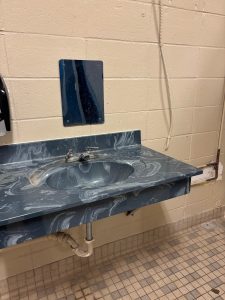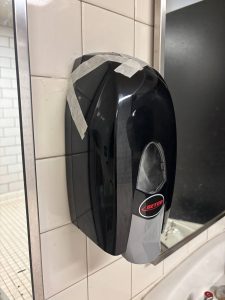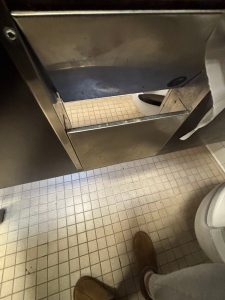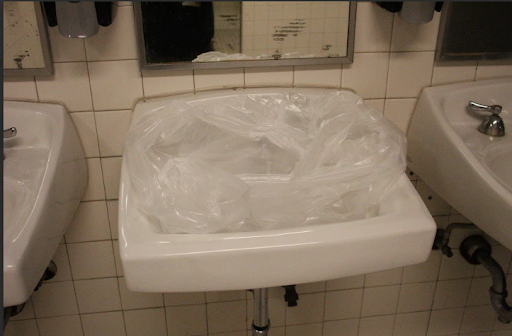As students, we spend over seven hours a day at school: a place that is supposed to support learning and growth, and foster respect. Yet, when it comes to something as basic as functioning bathrooms, our school fails us miserably.
Broken locks, malfunctioning toilets, outdated sinks and showers that are almost completely unusable are part of our everyday reality. These problems aren’t just inconvenient—they’re a clear message that student needs are not a priority.
Missouri state standards for school facilities require that restrooms and showers “be maintained in a sanitary, operational condition and provide adequate privacy.”
Our bathrooms do not meet this standard. Privacy is a consistent issue, with openings in stall walls and locks that don’t work. Many toilets remain out of service for weeks, creating long lines or forcing students to go across the building just to find a functioning restroom, which often leads to students being tardy to class. Handwashing is another challenge, with broken soap dispensers that remain unrepaired, especially in the men’s bathroom across from room 223.
Then there are the showers. In the women’s physical education locker rooms, one of eight showers are in usable condition. Athletes and students who need them after physical education and sports practices are left with no option but to go without a shower because the water pressure is barely a trickle—or non-existent. This lack of functionality doesn’t just cause inconvenience—it’s embarrassing and unsanitary.

“It’s just so annoying to deal with after practice,” senior Ellie Eastman said. “After swim practice, I need to rinse the chlorine off but there is only one working shower in the P.E. locker room, and that one shower is gross.”
What’s even more frustrating is that while our bathrooms remain outdated and unusable, the school seems to have no problem finding money for other projects. Recently, funds were allocated for a new hall pass system and huge fencing upgrades. These improvements are needed, but why are they taking precedence over basic necessities like bathrooms that are in such disrepair?
English teacher Ellen Wilson, a member of the school’s leadership council, provided some insight into the issue.
Wilson explained that some bathrooms remain locked during the school day due to a lack of supervision.
“The bathrooms by concessions have many stalls and are in very good condition, but they are locked during the day because there is no supervision in that area,” Wilson said.
This means that students are forced to rely on the most used bathrooms, primarily those on the east side of the building, which are also in the worst condition.
“The upstairs bathrooms on the east side are in the worst shape and are in need of renovation the most,” Wilson said.
The state of our bathrooms isn’t just a hygiene problem; it’s a reflection of the school’s priorities. How are students supposed to focus on academics when something as simple as going to the bathroom becomes a stressful experience?

Students in neighboring schools don’t have to deal with the same frustrations we do. Their bathrooms are newer, well-maintained, clean, and functional. Their stall doors close properly, their toilets flush, and their sinks and showers provide consistent water pressure. These seemingly small details make a world of difference in how students perceive their school environment.

A Hickman student, Sarah Evelev, visits the Career Center at Rock Bridge High School every day. She spoke on the clear contrast between the schools’ bathrooms.
She’s noticed, “[The] bathrooms I’ve been in at Rockbridge are definitely cleaner and better maintained than Hickman bathrooms,” Sarah said.
The District must prioritize investing in bathroom renovations. Fixing the plumbing to ensure that all toilets, sinks, and showers are functional is a basic starting point. Beyond that, upgrading the facilities to include newer features and secure stall doors would make a significant difference in student comfort and dignity.
The benefits of clean, functional bathrooms go beyond convenience. Research from the National Center for Education Statistics shows that schools with updated facilities report better student hygiene, improved morale and higher academic performance. Students perform better when they feel respected and comfortable in their environment.
As students, we deserve facilities that meet our basic needs. These bathrooms are more than a hygiene issue—they are a statement about how the school values its students. Right now, that statement is far from positive. It’s time for the administration and district leaders to act.
Allocating funds, seeking grants, or reallocating resources are all possible solutions to address this problem. Fixing the bathrooms is not a luxury, it’s a necessity.
We’re asking for dignity, respect, and the ability to focus on learning without worrying about the state of our facilities. Students spend hours in this building every day, from school to extracurriculars—it’s only fair that we have bathrooms that reflect the value of our education and well-being.







